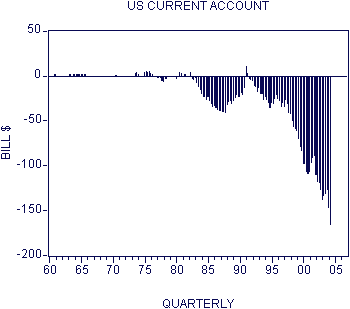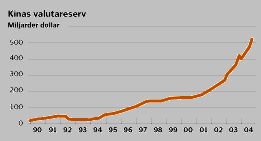New
Era
US
Trade Deficit
Martin Wolf
Fler inlägg på
Nat Ek För
Klas Eklund
NAIRU
Dollar
Home |
The imbalances are now enormous, far more glaring than at any point in the past.
Reducing any one imbalance to zero, or even compressing them all to a more manageable level, appears to be impossible without a major upheaval
Peter Bernstein, cit. by John Mauldin 23/12 2005
Kan man undvika recession i USA när man måste minska importen med 600 miljarder dollar?
Rolf Englund på Nationalekonomiska Föreningen 30/11 2004
Citerat ur minnet - referat i Ekonomisk Debatt 2/2005
Talare på mötet var Klas Eklund och Hans Genberg
- Jag har länge oroat mig för dollarn och underskottet i USA:s handelsbalans. Men jag blev i dag ändå mera oroad när Klas Eklund - en av vårt lands skickligaste ekonomer - sade sig inte veta vad man bör göra åt saken. Om inte Klas vet, vem vet då?
Jag vill fästa uppmärksamheten på årtalen 1982 och 1992 i Klas första diagram över det amerikanska handelsunderskottet. Det visar att dessa märkesår i svensk ekonomisk politik var de enda år som USA hade balans i sin utrikeshandel.

Hur skall man kunna ta ifrån de amerikanska konsumenterna 600 miljarder dollar utan att det leder till en amerikansk recession som inte kommer att bli rolig för någon? Finns det teoretiska och praktiska metoder detta?
Kinas centralbank har de senaste åren köpt dollarpapper för hundratals miljarder dollar. Kina har också förklarat att man avser att med tiden övergå till flytande växelkurs.

Men om man har flytande växelkurs, vilket man bör, behöver man i princip inte någon valutareserv (i vart fall behöver man en avsevärt mindre valutareserv). Kommer inte Bank of Chinas innehav av dollar-obligationer att innebära ett stort "overhang"?
One way or another, the economy will eventually eliminate both imbalances.
But if the process doesn't go smoothly - if, in particular, the housing bubble bursts before the trade deficit shrinks - we're going to have an economic slowdown, and possibly a recession.
In fact, a growing number of economists are using the "R" word for 2006
Paul Krugman, New York Times, August 29, 2005
To bring about a substantial reduction in the external deficit without a deep recession, the US needs a huge change in internal relative prices.
About Maurice Obstfeld and Kenneth Rogoff The Unsustainable US Current Account Position Revealed
Martin Wolf Financial Times 1/12 2004
The rising balance of payments deficit implies that the budget deficit must get progressively worse from now on if stagnation is to be avoided.
Wynne Godley and Alex Izurieta Financial Times December 3 2004
Top of page
|
If a weaker dollar can’t do the trick, what can?
The answer, in my view, is real interest rates
The only way America can ever get a handle on its trade and current account conundrum is on the import side of the equation. After all, imports are currently 52% larger than exports (in real terms), making it almost mathematically impossible for the US to export its way out of its trade deficit.
In looking at real US interest rates over the broad sweep of history, there’s nothing but upside from current levels. The real federal funds rate remains around “zero” and the real rate on a 10-year Treasury note is down to its post-1986 low of 0.7%.
Stephen Roach 14/1 2005
It wasn’t supposed to be this way. Global rebalancing appears to be stymied. Nearly three years into the dollar’s correction and the US trade gap keeps hitting new records. The external deficit on goods and services widened to a staggering $60 billion in November 2004. I’m old enough to remember when this would be a bad number for a year! This seemingly anomalous outcome reflects an important new shift in the macro fabric of the US economy -- a diminished sensitivity to currency fluctuations. That means it will probably take more than just a weaker dollar to spark global rebalancing.
The diminished sensitivity of the US economy to currency fluctuations has been increasingly evident over the past 15 years. Normally, a weakening currency results in a narrowing of a nation’s current account deficit and a pick-up in inflation. That’s pretty much what happened in the 1970s and especially in the late 1980s in the aftermath of the dollar’s sharp downward adjustment during most of that latter period.
But then it all seemed to change in the 1990s. The dollar’s decline in the first half of that decade was accompanied by a shift in the current account from surplus back to deficit. And inflation barely budged. A similar outcome has been evident in the past three years -- a 16% decline in the broad dollar index (in real terms) accompanied by an ever-widening current-account deficit and persistently low inflation.
It’s not altogether clear why this relationship has broken down. My suspicion is that globalization is the main culprit. The globalization of supply chains biases import content to the upside for the high-cost developed world; it also forces the advanced economies to abdicate price setting at the margin to low-cost producers in the developing world. The result is a sharply diminished industrial base in countries like the United States. Manufacturing employment currently stands at only about 13% of America’s private nonfarm workforce -- down sharply from the nearly 23% share that prevailed in the mid-1980s, the last time the dollar entered a serious correction.
Moreover, value-added in the US manufacturing sector fell to only about 14% in 1993-- down from 20% in 1985. The sharply diminished size of America’s industrial base makes it exceedingly difficult for the US to turn dollar depreciation into an advantage and trade its way out of a severe current-account problem through enhanced export growth and import substitution.
based on current account adjustments of the past, there’s good reason to believe that the broad dollar index has a good deal more to go on the downside. However, due to America’s reduced currency elasticities, a weaker dollar no longer appears to be a sufficient condition to complete the global rebalancing process.
If a weaker dollar can’t do the trick, what can? The answer, in my view, is real interest rates -- the price adjustment that could well qualify as the sufficient condition for America’s role in global rebalancing.
The only way America can ever get a handle on its trade and current account conundrum is on the import side of the equation. After all, imports are currently 52% larger than exports (in real terms), making it almost mathematically impossible for the US to export its way out of its trade deficit.
Needless to say, the saving-short, overly-indebted, and asset-dependent American consumer should feel the impacts of such an adjustment most acutely. But homebuilding will also be hit, as will business capital spending to a more limited extent.
Full text
Real interest rates
Dollar
top

